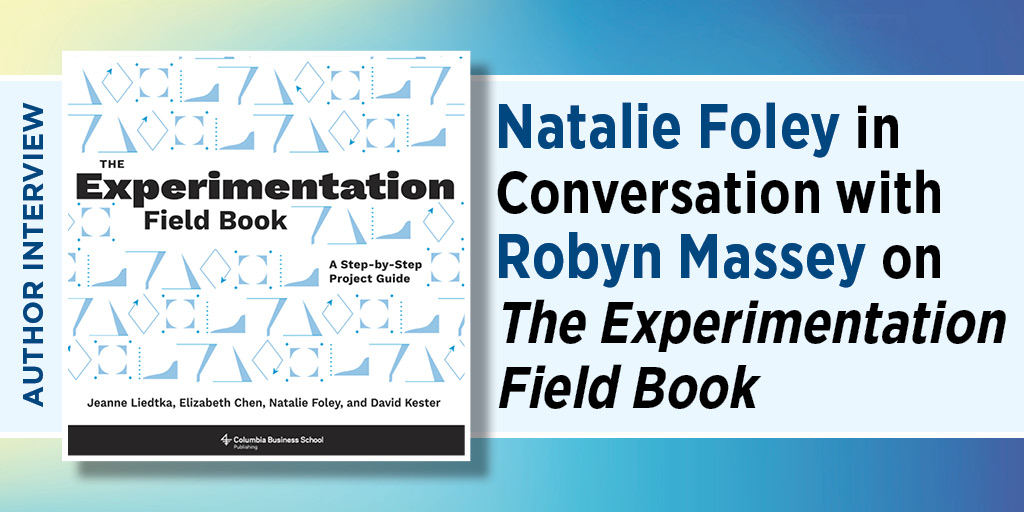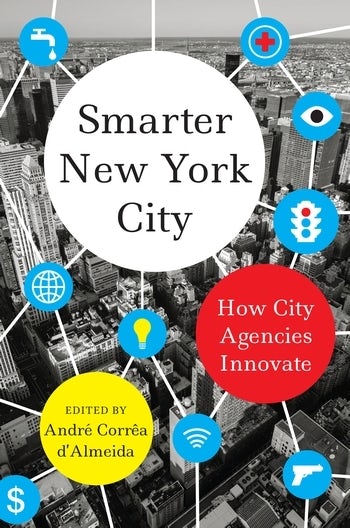Natalie Foley in Conversation with Robyn Massey on The Experimentation Field Book

Organizations place great value on innovation. Yet to achieve innovation—whether via new products, services, or strategies—experimentation is key. Indeed, experimentation is the link between generating new ideas and putting them into practice. On the face of it, this sounds straightforward. In reality, however, there is a shortage of actionable guidance on how to design and execute high-quality experiments for practical purposes. This lack is why Jeanne Liedtka, Elizabeth Chen, Natalie Foley, and David Kester were motivated to write The Experimentation Field Book: A Step-by-Step Project Guide. In this conversation, coauthor Natalie Foley opens up to Robyn Massey about their passion for navigating complex issues with a clean and clear process.
Robyn Massey: You have noted that your primary audiences for this book are working in the fields of business, innovation, product development, and design thinking. Large enterprises tend to embark on huge, complicated product launches. You propose breaking that down into smaller chunks. How would someone approach the conversation to change from one big product launch to smaller tests?
Natalie Foley: In The Experimentation Field Book, we talk about how many teams believe there are only two paths they can take when they have a new idea. One, they can go directly from the idea to a product launch with all the inherent risks that action includes. Or two, they can do nothing with the new idea. This second choice isn’t always proclaimed as a choice, but the leap to just “launching” a new idea seems really daunting so it just fizzles. This book offers a third path: Test your new concept with a series of small experiments. Each experiment is time bound, with tests for a specific goal?, and ends with clear evidence to move the concept forward as is, tweak it while moving forward, or shelve it. These experiments give your team the data to make this decision confidently.
What’s important to note is that most product launches do not include many tests that try and learn about desirability (do any users/customers want this and why); instead, product launches focus on feasibility (how to make it work). It’s expensive and inefficient to learn after the build that people don’t want what you’ve built. This book offers that alternative third path so that you learn before the build if people want it and have time to pivot.
Massey: For those who already lead innovative experimentations at their companies, what is new about this book?
Foley: There are other books out there that offer comprehensive guides to all things testing. Our book is different in the fact that it is a succinct, simplified field book meant to guide innovators through a particular project in five easy steps. It breaks down running experiments in tangible ways, opening up an accessible pathway into experimentation.
Many people that we’ve spoken to who have run experiments before do so by intuition or gut feel, often innovating as they go. This method can provide great success, yet questions remain over whether they chose the right things to test, whether they missed insights along the way, or whether they could then go ahead and do it again. Also, many of us like having processes and leaning on them over intuition, particularly if we’re new to this type of work.
This field book provides an answer to all those questions. It delivers a structure for experimentation, and it will enable readers not only to learn how to do one type of experiment, but also to formulate multiple avenues, from choosing the right experiment to prototypes. This way, they can improve their process of experimentation and get better results. With industry-proven tools included, it really makes experimentation accessible in a way that hasn’t been done before.
Lastly, many books focus on the steps before and after experimentation. Steps before are more traditionally centered around learning about customers’ needs, so that means books on customer discovery, design thinking, human-centered design, etc. Steps after experimentation deal with the complexity of building/launching a new product—agile, product development, lean startup, and so on. These books all assume that you know what you’re building. This book sits right in the middle, helping teams bridge that important gap and validate the solution before building it.
Massey: As authors and practitioners, you are well known in the design thinking field. Now you offer a book on experimentation. How do you differentiate between the two fields? How do they complement each other, overlap or interplay? How do you think about the two fields? When do you apply one over the other or along with the other?
Foley: Design thinking as a methodology, both in practice and teaching resources, largely stops after customer discovery, or human-centered/ethnographic design research and synthesis, and leads to a few concepts. We often describe it as the “front end of the innovation process.” On the other end, the “back end of the innovation process” are the product development methodologies—agile, lean startup, etc. These methodologies assume that the design and features coming into the process were mostly accurate. Therefore, product development tools center around “how to build.” There is this gap in between the two. Design thinking leaves you with “build for this problem,” but there’s a huge leap to “how to build this.” Experimentation is “what to build.” This missing piece is where the de-risking occurs, so that you feel you’re spending your money and time effectively in the more expensive, time-consuming product development and build phase.
Notice the translation I’m doing with words like “design thinking,” “experimentation,” etc. These words are unapproachable, hard to understand, and have a myriad of definitions. Not to mention they all share some similar entrepreneurial, iterative DNA. They are each problem-solving tools optimized for different stages of innovation.
Massey: What most excites you about this book?
Foley: The power of experimentation has been really life-changing for me. I often joke that I thought I was pretty smart until I got to business school when I was thirty years old and it was 2009. The economy had collapsed and, at the same time, major tech firms like Amazon were fundamentally shifting every single sector. So, in business school, to do a business case like “So you’re the CEO of Marriott and Hilton just built a budget brand for younger consumers, how do you compete?” felt far behind the times. If I’m the CEO of Marriott, I’m thinking: “I know someone who just paid money to sleep in a room at a stranger’s house. What am I going to do about Airbnb?” That is when I started to feel not smart—that in this new economy there would be no right answers, no data in the back of the case to pour over and sort out a decent response. I was dealing with “unknown unknowns” as they say, not “known unknowns.” But I luckily took an Innovation and Design Thinking class (with my coauthor Jeanne Liedtka!) and realized I didn’t have to be right all the time. I just had to listen to what users were telling me by running a solid experiment—they would tell me the answers. This was really liberating. I felt like I finally had a toolkit to tackle some of the business, social, and environmental challenges that had no clear answers.
I want others to feel this way, which is why I helped write the book. I wanted this toolkit to be democratized and DIY; not theoretical in nature but something someone could pick up and immediately use to solve a new challenge. The Experimentation Field Book is the end result of all that.





